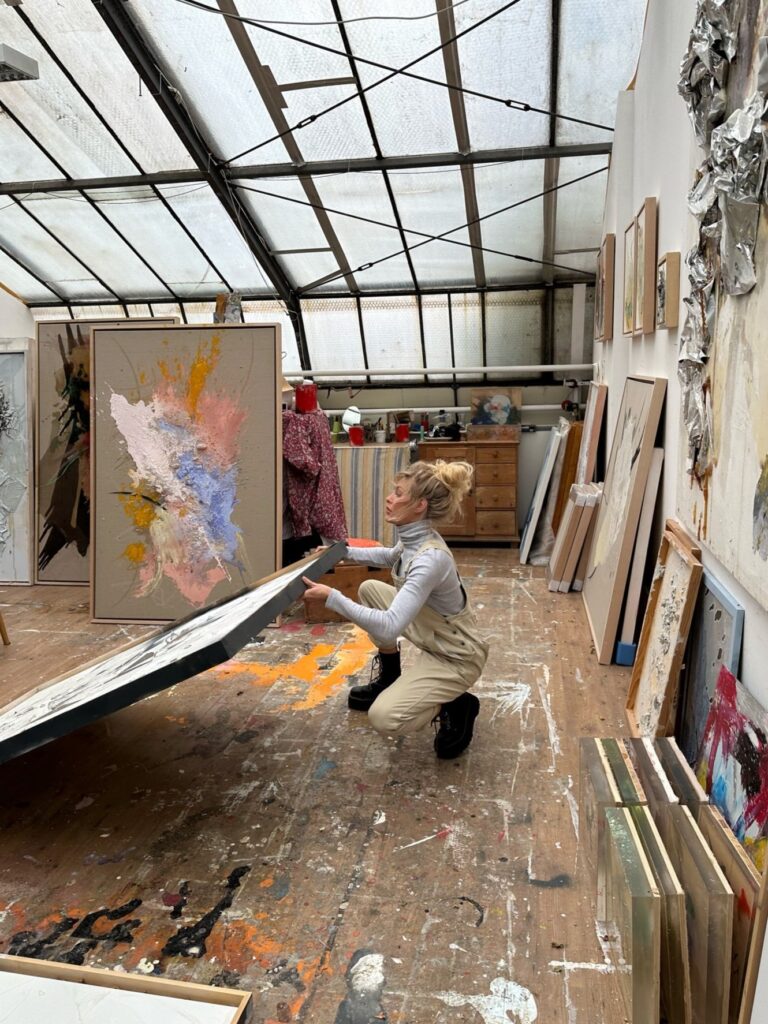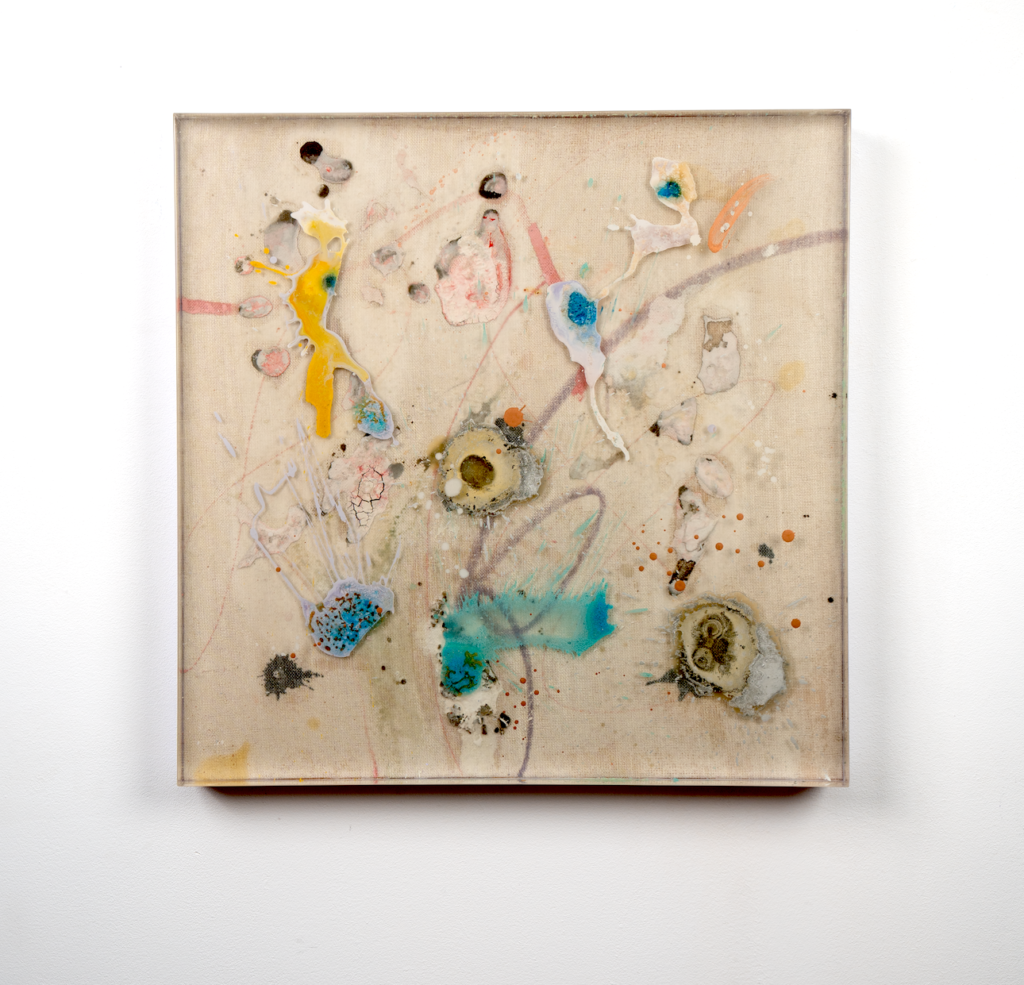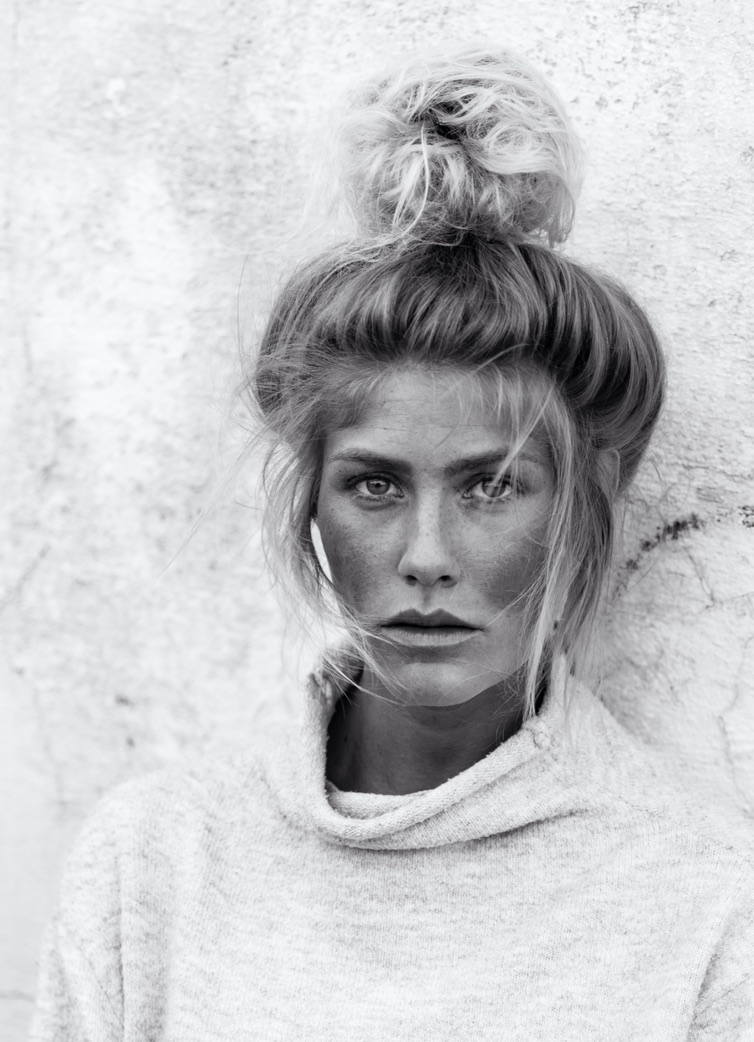Anna van den Hoevel is a German artist who had a peripatetic childhood growing up between the Bavarian city of Munich, the Austrian alps and the Menorcan coast. Influences of the city, the mountains and the sea infiltrate her paintings, which combine her love or nature with a wanderlust that has permeated her life.
Van den Hoevel has exhibited work in Europe, North America, China and South Africa and traveled across all continents. Visual mementos gathered during her travels are reflected in her abstract artworks, which often capture a bird’s-eye view of landscapes or seascapes. She has created a unique visual vocabulary that explores issues of environmentalism, light, materiality and the human psyche. Van den Hoevel’s paintings are in the lineage of the abstract expressionist school, while she has a deep interest in blending materiality with symbolism and gesture.
Culturalee spoke to van den Hoevel about recent exhibitions in China, her inspirations and her series of artworks including Birdview, Expression, Worldstrip and the new METAS paintings.

During a relatively short career you have already built up an impressive biography, with exhibitions in China, South Africa, Switzerland, Germany and the USA. You’ve had two exhibitions in China this year already – Eurovisons: A Kaleidoscope of European Art in China at the Songzhuaung Contemporary Art Archive Museum in Beijing and Transcendence at the Hong Art Museum in China. There are traces of Asian art history in your paintings and your mark-making evokes ancient Chinese calligraphy in a way. Do you draw any inspiration from Chinese art and how were your paintings received in China?
Chinese art has profoundly influenced my work, both in terms of technique and philosophy. I am particularly inspired by the concept of “Qi”, or the life force, which is central to traditional Chinese art. The idea that every brushstroke should carry this vital energy, conveying a sense of life and movement, resonates deeply with my approach to painting. In my work, I strive to capture that same sense of fluidity and spontaneity, using marks that are both deliberate and dynamic.
Exhibiting in China was a profound experience. The audiences there showed a deep appreciation for the nuances in my work, especially the connections to their own artistic traditions. The reception was overwhelmingly positive, with viewers noting how my work resonated with aspects of Chinese aesthetics. It was an honor to see my art interpreted and valued within such a rich cultural context, and the experience has further deepened my respect for Chinese art, pushing me to explore these influences even more in my future work.
You had a peripatetic childhood, living between Menorca, the Austrian Alps and Munich. How did this experience of coastal life, the mountains and Bavarian city life inform your artistic practice?
My childhood, moving between the rugged coasts of Menorca, the serene Austrian Alps, and the vibrant city life of Munich, has deeply shaped my artistic practice. Each of these environments offered unique sensory experiences that continue to influence the themes, colors, and textures in my work.
Altogether, these various landscapes and lifestyles have given me a broad palette to draw from, both literally and metaphorically. My fascination with the world from above has taught me to see the beauty in patterns and the connections between seemingly disparate elements. This elevated perspective is at the heart of my artistic practice, guiding the way I interpret and represent the world around me. By adopting the bird’s-eye view, I aim to offer viewers a fresh perspective—one that invites them to look beyond the obvious and discover the intricate beauty that emerges when we change the way we see.
Where did you study art or where you self-taught?
I studied art in England, where I spent four years at a boarding school, ultimately completing my International Baccalaureate with a strong focus on art. This period really shaped my technical skills and deepened my understanding of art history and theory. This structured environment also provided me with the discipline to explore different mediums and techniques, while also encouraging me to develop a personal style.
Before that, I attended a Montessori school, where the approach to learning was much more open and exploratory. From an early age, I was given the freedom to experiment with materials and express myself creatively without the constraints of traditional art instruction. This early exposure nurtured my fascination with abstraction and allowed me to develop a deep connection with the tactile and material aspects of art.
These two educational experiences—first the freeform, exploratory environment of the Montessori school, followed by the more structured and focused training in England—have both played significant roles in shaping my artistic identity. They allowed me to balance intuition and spontaneity with technique and discipline, which are key elements in my work today.
You use natural materials to create texture in your paintings, and the way you create a visual language using symbols and sweeping gestures on your canvases reminds me of Catalan artist Antoni Tapies. Were you influenced at all by Tapies, and who are your main artistic influences?
Antoni Tapies’s use of natural materials and his approach to creating texture in his work have indeed been an inspiration for me. His ability to convey depth and complexity through the manipulation of surfaces and the incorporation of everyday materials resonates with my own exploration of texture and form. While my work is not directly modeled after Tapies, his emphasis on materiality and abstract expression has influenced my approach to creating my own visual language on the canvas.
In addition to Tapies, I draw inspiration from a range of artists and traditions. I’m influenced by the conceptual and tactile qualities found in abstract expressionism, as well as the meditative aspects of traditional Asian art. The works of artists who blend materiality with symbolism and gesture, such as Yves Klein and Jean Dubuffet, also contribute to my creative process. Each of these influences informs my exploration of textures, symbols, and sweeping gestures, helping me to develop a unique visual language that reflects my personal experiences and artistic vision.
Your ‘Birdview’ series celebrates abstract forms of our planet seen from the POV of a bird. What was the starting point for this series, and do you use drone photography to capture natural phenomena from above and then create your paintings?
Birdview celebrates abstract forms from the perspective of a bird and my experiences of frequent air travel. As a child, I was captivated by the view from the plane window, observing the intricate patterns and shapes of the landscape below. This fascination with aerial perspectives eventually inspired me to start taking photographs from these vantage points.
While I do use drone photography to capture and explore these views in greater detail, the core of the series is rooted in how I experience and interpret the places I travel and the memories formed during such times. My work combines these aerial perspectives with my personal impressions and emotional responses to different landscapes. The abstract forms and textures in my paintings are a reflection of both the visual stimuli I encounter and the unique ways I engage with the world around me.

Although your paintings are abstract, you weave a visual narrative through each canvas and succeed in telling stories or evoking emotional responses through your choice of palette. For example your Berlin series uses a dark palette and evokes the darker side of the human psyche, while your Expression and Worldstrips series utilise a more joyful, colourful palette inspired by the sea, the beach or the mountains. What draws you to a place and makes you want to paint it or capture its essence on canvas?
What draws me to a place and inspires me to capture its essence on canvas is a combination of personal experience and emotional resonance. Each location I encounter—whether it’s a city, a natural landscape, or a specific environment—evokes a unique response within me, which influences the way I translate that experience into my paintings.
The Berlin series reflects a more introspective side of the human psyche, which I express through a muted, somber palette. This series was inspired by the city’s complex history and its profound impact on me during my time there. The darker tones and textures in these works aim to evoke a sense of depth and contemplation, capturing the essence of Berlin’s atmosphere and my emotional response to it.
Similarly, the Expression and Worldstrips series use vibrant colors inspired by the sea, the beach, and mountainous landscapes. However, these series are not solely about positivity. While they capture the beauty and dynamism of these environments, they also reflect the complex and sometimes challenging experiences I’ve had in these places. The colors and forms in these works convey a range of emotions and reactions, from the exhilaration of nature’s grandeur to the introspective moments of solitude.
This approach allows me to portray the multifaceted nature of each location and the varied emotional experiences they inspire.

There is something very cellular about your METAS series, with mark-making that resembles DNA or the distilled essence of our planet, while the motifs and shapes you create recall the abstract vocabulary of Kandinsky. What was the starting point for the METAS series and where did you draw inspiration from?
The METAS series is inspired by the concept of metamorphosis and the evolving nature of our world. I was intrigued by how everything is in a constant state of transformation, whether it’s the natural environment or the progression of human technology and society. This series explores these ideas through a cellular and abstract visual language, reflecting the idea of transformation at both a microscopic and macroscopic level.
I hadn’t thought of it in that way before but the mark-making in the METAS series does resemble DNA structures and the fundamental elements of our planet. In other words, an ongoing metamorphosis. I sought to capture the essence of change and evolution, incorporating motifs and shapes that perhaps echo the abstract vocabulary of such artists like Kandinsky, while also aiming to create a cohesive narrative that reflects both the intrinsic changes within our world and the broader evolution of my own artistic practice. The METAS series really represents a step forward in my work, connecting these themes of transformation with the abstract, elemental forms that are central to my art practice.
‘Art is inexplicable until you know its creator, and Anna is pure joy.” This is a quote about you. Do you feel that your paintings are an extension of your psyche?
I’m deeply honored by that quote, and I do believe that my paintings are a reflection of my inner world. Painting is an intensely personal process. When I create, it’s as if I’m translating emotions, thoughts, and experiences onto the canvas. The psyche is fluid and multifaceted, and I think that comes through in the varying textures, colors, and themes I explore in my work. While I don’t always start with a concrete intention or message, I find that my subconscious often reveals itself in the final piece, offering a glimpse into my mind and emotions. In this way, my paintings are very much an extension of who I am, an ongoing dialogue between my inner self and the external world.
You make a concerted effort to use natural materials and often approach local paint companies to request leftover paints for reasons of sustainability. Are issues of the environment and climate change important to you, and how do you reflect this in your work?
Absolutely, environmental sustainability is a critical concern for me, both personally and professionally. The natural world is a constant source of inspiration in my art, so it feels only right to honor that by working sustainably when I can. As you point out, I strive to minimize waste by repurposing leftover paints and materials, which also brings an element of serendipity to my creative process. Each color or texture carries its own history and story, which adds layers of meaning to the final piece.
Can you talk a bit about what exhibitions and projects you have coming up?
I’m thrilled about the upcoming exhibitions that are scheduled over the next couple of years. First, from October 24 to December 7, 2024, I will be participating in EuroVistas in Weiz: A Journey Through European and Asian Contemporary Art at Kunsthaus Weiz in Austria. This exhibition is particularly exciting because it brings together a vibrant mix of European and Asian art, fostering cultural dialogue and understanding. Many of the works in this exhibition were previously shown in China, and it’s a privilege to see them presented to a European audience. The exhibition’s focus on diverse art forms—from avant-garde sculptures to paintings—mirrors the eclectic nature of my own practice, and I’m looking forward to seeing how my work interacts with pieces from different cultural backgrounds.
In March through May of 2025, my work will be featured at the Pashmin Art Gallery in Hamburg. This gallery has a strong reputation for promoting contemporary art, and I’m eager to present a new series that continues to explore themes of nature, memory, and the human psyche. Later, in November 2025, I’ll be part of an international group exhibition at the Schlossmuseum Greiz in Germany. This exhibition, organized by the Pashmin Art Consortia, will highlight the diversity and creativity of artists from various countries, including Germany, Austria, Denmark, and China. The historic setting of the Schlossmuseum will provide a rich backdrop that complements the contemporary works on display, and I’m excited to see how this dialogue between old and new will unfold.
Finally, from December 2025 to February 2026, I’ll have the honor of showing my work at the Rothko Museum in Latvia. This collaboration with the Rothko Museum and Pashmin Art Consortia is an incredible opportunity to engage with a space dedicated to one of the pioneers of abstract expressionism. The exhibition will be part of a curated collection that showcases the diverse landscape of modern art, emphasizing art’s role as a dynamic global force.



